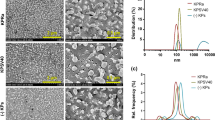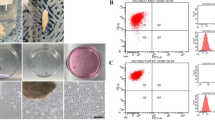Abstract
Following the failure of a Phase II clinical study evaluating human retinal pigment epithelial (hRPE) cell implants as a potential treatment option for Parkinson’s disease, speculation has centered on implant function and survival as possible contributors to the therapeutic outcomes. We recently reported that neonatal hRPE cells, similar to hRPE cells used in the Phase II clinical study, produced short-lived in vitro and limited in vivo trophic factors, which supports that assumption. We hypothesize that the switch from fetal to neonatal hRPE cells, between the Phase I and the Phase II clinical trial may be partly responsible for the later negative outcomes. To investigate this hypothesis, we used two neonatal hRPE cell lots, prepared in a similar manner to neonatal hRPE cells used in the Phase II clinical study, and compared them to previously evaluated fetal hRPE cells for behavioral changes following unilateral striatal implantation in 6-hydroxydopamine-lesioned rats. The results showed that only fetal, not neonatal, hRPE cell implants, were able to improve behavioral outcomes following striatal implantation in the lesioned rats. These data suggest that fetal hRPE cells may be preferential to neonatal hRPE cells in restoring behavioral deficits.



Similar content being viewed by others
References
Airaksinen MS, Saarma M (2002) The GDNF family: signalling, biological functions and therapeutic value. Nat Rev Neurosci 3:383–394
Apostolides C, Sanford E, Hong M, Mendez I (1998) Glial cell line-derived neurotrophic factor improves intrastriatal graft survival of stored dopaminergic cells. Neuroscience 83:363–372
Bakay RA, Raiser CD, Stover NP, Subramanian T, Cornfeldt ML, Schweikert AW, Allen RC, Watts R (2004) Implantation of Spheramine in advanced Parkinson’s disease (PD). Front Biosci 9:592–602
Baluchnejadmojarad T, Roghani M (2004) Evaluation of functional asymmetry in rats with dose-dependent lesions of dopaminergic nigrostriatal system using elevated body swing test. Physiol Behav 82:369–373
Binder S, Stanzel BV, Krebs I, Glittenberg C (2007) Transplantation of the RPE in AMD. Prog Retin Eye Res 26:516–554
Borlongan CV, Sanberg PR (1995) Elevated body swing test: a new behavioral parameter for rats with 6-hydroxydopamine-induced hemiparkinsonism. J Neurosci 15:5372–5378
Boulton M, Roanowska M, Wess T (2004) Ageing of the retinal pigment epithelium: implications for transplantation. Graefes Arch Clin Exp Ophthalmol 242:76–84
Burke JM, McKay BS (1993) In vitro aging of bovine and human retinal pigment epithelium: number and activity of the Na/K ATPase pump. Exp Eye Res 57:51–57
Burke JM, Skumatz CM, Irving PE, McKay BS (1996) Phenotypic heterogeneity of retinal pigment epithelial cells in vitro and in situ. Exp Eye Res 62:63–73
Cepeda IL, Flores J, Cornfeldt ML, O’Kusky JR, Doudet DJ (2007) Human retinal pigment epithelial cell implants ameliorate motor deficits in two rat models of Parkinson disease. J Neuropathol Exp Neurol 66:576–584
Choi-Lundberg DL, Lin Q, Chang YN, Chiang YL, Hay CM, Mohajeri H, Davidson BL, Bohn MC (1997) Dopaminergic neurons protected from degeneration by GDNF gene therapy. Science 275:838–841
Chou K, Hurtig H (2005) Classical Motor Features of Parkinson’s Disease. In: Ebadi Manuchair, Pfeiffer Ronald F (eds) Parkinson’s Disease. CRC Press, New York, pp 171–181
Doudet DJ, Cornfeldt ML, Honey CR, Schweikert AW, Allen RC (2004) PET imaging of implanted human retinal pigment epithelial cells in the MPTP-induced primate model of Parkinson’s disease. Exp Neurol 189:361–368
Falk T, Congrove NR, Zhang S, McCourt AD, Sherman SJ, McKay BS (2012) PEDF and VEGF-A output from human retinal pigment epithelial cells grown on novel microcarriers. J Biomed Biotechnol 2012:278932
Farag ES, Vinters HV, Bronstein J (2009) Pathologic findings in retinal pigment epithelial cell implantation for Parkinson disease. Neurology 73:1095–1102
Flores J (2011) Human retinal pigment epithelial cell transplantation for the treatment of Parkinson’s disease. Ph.D. dissertation, University of British Columbia
Flores J, Cepeda IL, Cornfeldt ML, O’Kusky JR, Doudet DJ (2007) Characterization and survival of long-term implants of human retinal pigment epithelial cells attached to gelatin microcarriers in a model of Parkinson disease. J Neuropathol Exp Neurol 66:585–596
Gross RE, Watts RL, Hauser RA, Bakay RA, Reichmann H, von Kummer R, Ondo WG, Reissig E, Eisner W, Steiner-Schulze H, Siedentop H, Fichte K, Hong W, Cornfeldt M, Beebe K, Sandbrink R (2011) Intrastriatal transplantation of microcarrier-bound human retinal pigment epithelial cells versus sham surgery in patients with advanced Parkinson’s disease: a double-blind, randomised, controlled trial. Lancet Neurol 10:509–519
Hu J, Bok D (2001) A cell culture medium that supports the differentiation of human retinal pigment epithelium into functionally polarized monolayers. Mol Vis 7:14–19
Ito S, Wakamatsu K (2008) Chemistry of mixed melanogenesis–pivotal roles of dopaquinone. Photochem Photobiol 84:582–592
Katsnelson A (2011) Experimental therapies for Parkinson’s disease: why fake it? Nature 476:142–144
Kolomeyer AM, Sugino IK, Zarbin MA (2011) Characterization of conditioned media collected from cultured adult versus fetal retinal pigment epithelial cells. Invest Ophthalmol Vis Sci 52:5973–5986
Luo Y, Zhuo Y, Fukuhara M, Rizzolo LJ (2006) Effects of culture conditions on heterogeneity and the apical junctional complex of the ARPE-19 cell line. Invest Ophthalmol Vis Sci 47:3644–3655
Maminishkis A, Chen S, Jalickee S, Banzon T, Shi G, Wang FE, Ehalt T, Hammer JA, Miller SS (2006) Confluent monolayers of cultured human fetal retinal pigment epithelium exhibit morphology and physiology of native tissue. Invest Ophthalmol Vis Sci 47:3612–3624. doi:10.1167/iovs.05-1622 ([pii]: 47/8/3612)
Mayer E, Dunnett SB, Pellitteri R, Fawcett JW (1993) Basic fibroblast growth factor promotes the survival of embryonic ventral mesencephalic dopaminergic neurons–I. Effects in vitro. Neuroscience 56:379–388
McKay BS, Goodman B, Falk T, Sherman SJ (2006) Retinal pigment epithelial cell transplantation could provide trophic support in Parkinson’s disease: results from an in vitro model system. Exp Neurol 201:234–243
Ming M, Li X, Fan X, Yang D, Li L, Chen S, Gu Q, Le W (2009) Retinal pigment epithelial cells secrete neurotrophic factors and synthesize dopamine: possible contribution to therapeutic effects of RPE cell transplantation in Parkinson’s disease. J Transl Med 7:53
Nutt JG (2001) Motor fluctuations and dyskinesia in Parkinson’s disease. Parkinsonism Relat Disord 8:101–108
Olanow CW, Goetz CG, Kordower JH, Stoessl AJ, Sossi V, Brin MF, Shannon KM, Nauert GM, Perl DP, Godbold J, Freeman TB (2003) A double-blind controlled trial of bilateral fetal nigral transplantation in Parkinson’s disease. Ann Neurol 54:403–414
Olanow CW, Obeso JA, Stocchi F (2006) Continuous dopamine-receptor treatment of Parkinson’s disease: scientific rationale and clinical implications. Lancet Neurol 5:677–687
Olsson J (2011) The Newborn. In: Kliegman R, Nelson WE (eds) Nelson textbook of pediatrics, 19th edn. Elsevier/Saunders, Philadelphia, PA, pp 26.e9–26.e12
Parent A, Cote PY, Lavoie B (1995) Chemical anatomy of primate basal ganglia. Prog Neurobiol 46:131–197
Parkinson Study Group (2000) Pramipexole vs levodopa as initial treatment for Parkinson disease: a randomized controlled trial. Parkinson Study Group. JAMA 284:1931–1938
Paxinos G, Watson C (1998) The rat brain in stereotaxic coordinates, 4th edn. Academic Press, San Diego
Peterson AL, Nutt JG (2008) Treatment of Parkinson’s disease with trophic factors. Neurotherapeutics 5:270–280
Rak DJ, Hardy KM, Jaffe GJ, McKay BS (2006) Ca++-switch induction of RPE differentiation. Exp Eye Res 82:648–656
Rubin E, Farber JL (1999) Pathology, 3rd edn. Lippincott-Raven, Philadelphia
Russ K, Flores J, Brudek T, Doudet D (2016) Neonatal human retinal pigment epithelial cells secrete limited trophic factors in vitro and in vivo following striatal implantation in Parkinsonian rats. J Neural Transm 123:167–177
Sauer H, Fischer W, Nikkhah G, Wiegand SJ, Brundin P, Lindsay RM, Bjorklund A (1993) Brain-derived neurotrophic factor enhances function rather than survival of intrastriatal dopamine cell-rich grafts. Brain Res 626:37–44
Schallert T, Woodlee MT, Fleming SM (2002) Disentangling multiple types of recovery from brain injury. In: Krieglstein J (ed) Pharmacology of Cerebral Ischemia 2002, Medpharm Scientific Publishers Stuttgart, pp 201–216
Schallert T, Woodlee MT (2004) Motor systems: orienting and placing. In: Whishaw IQ, Kolb B (eds) The behaviour of the laboratory rat: a handbook with tests. Oxford University Press, New York, pp 129–140
Schapira AH (2009) Neurobiology and treatment of Parkinson’s disease. Trends Pharmacol Sci 30:41–47
Siegel GJ, Chauhan NB (2000) Neurotrophic factors in Alzheimer’s and Parkinson’s disease brain. Brain Res Brain Res Rev 33:199–227
Stover NP, Watts RL (2008) Spheramine for treatment of Parkinson’s disease. Neurotherapeutics 5:252–259
Stover NP, Bakay RA, Subramanian T, Raiser CD, Cornfeldt ML, Schweikert AW, Allen RC, Watts RL (2005) Intrastriatal implantation of human retinal pigment epithelial cells attached to microcarriers in advanced Parkinson disease. Arch Neurol 62:1833–1837
Subramanian T, Marchionini D, Potter EM, Cornfeldt ML (2002) Striatal xenotransplantation of human retinal pigment epithelial cells attached to microcarriers in hemiparkinsonian rats ameliorates behavioral deficits without provoking a host immune response. Cell Transplant 11:207–214
Tombran-Tink J, Shivaram SM, Chader GJ, Johnson LV, Bok D (1995) Expression, secretion, and age-related downregulation of pigment epithelium-derived factor, a serpin with neurotrophic activity. J Neurosci 15:4992–5003
Ungerstedt U, Arbuthnott GW (1970) Quantitative recording of rotational behavior in rats after 6-hydroxy-dopamine lesions of the nigrostriatal dopamine system. Brain Res 24(3):485–493
Watts RL, Raiser CD, Stover NP, Cornfeldt ML, Schweikert AW, Allen RC, Subramanian T, Doudet D, Honey CR, Bakay RA (2003) Stereotaxic intrastriatal implantation of human retinal pigment epithelial (hRPE) cells attached to gelatin microcarriers: a potential new cell therapy for Parkinson’s disease. J Neural Transm (Suppl):215–227
Watts RL, Gross RE, Hauser RA, Bakay RAE, Reichmann H, Eisner W, Stover NP, Reissig E, Steiner-Schulze H, Fichte K (2009) The STEPS Trial: a phase 2b study evaluating spheramine in patients with Advanced Parkinson’s Disease. Mov Disord 24(suppl. 1):LB-18
Zawada WM, Zastrow DJ, Clarkson ED, Adams FS, Bell KP, Freed CR (1998) Growth factors improve immediate survival of embryonic dopamine neurons after transplantation into rats. Brain Res 786:96–103
Acknowledgements
This research was supported by a grant from the UBC-CIHR Training Program in Transplantation. We would like to thank Dr. Michael Cornfeldt from Titan Pharmaceuticals and Dr. Branka Mitrovic from Bayer Schering Pharma for the gift of hRPE cells and microcarriers, which allowed these studies to be performed. Additionally, we thank Wesley Mah for assistance with behavioral evaluations and Rick Kornelsen, Chenoa Mah, and the personnel of the UBC Animal Resources Unit for technical assistance and support with the animals. Lastly, we want to acknowledge Dr. Bente Pakkenberg for her critical review of the manuscript.
Author information
Authors and Affiliations
Corresponding author
Rights and permissions
About this article
Cite this article
Russ, K., Flores, J., Brudek, T. et al. Differential behavioral outcomes following neonatal versus fetal human retinal pigment epithelial cell striatal implants in parkinsonian rats. J Neural Transm 124, 455–462 (2017). https://doi.org/10.1007/s00702-017-1683-1
Received:
Accepted:
Published:
Issue Date:
DOI: https://doi.org/10.1007/s00702-017-1683-1




